Oil testing kit Blog

Oil testing spectrometry workshop at Fab 10
I ran a small session on developing the oil test kit spectrometer yesterday in Barcelona (http://fab10.org). Basically, we've been trying to design a sample chamber so people can do quick and standardized fluorescence scans of different samples in small bottles. This seems like a good opportunity to revisit the design of our spectrometers in general and maybe even come up with a cheap foldable version of the whole thing. Mathew Lippincott and I have been working on this a bit (see links at upper left) and this workshop seemed to be a good opportunity to keep experimenting.
We built the sample holding chamber around the basic foldable spectrometer people have been building for years. It allows for a laser pen to be inserted but I think it'll make more sense with UV LEDs down the road.
It needs to be a bit taller since phones are so big -- kind of annoying. We used it sideways but the phone interface isn't ideal since the menu bar takes up so much space that way.
Aisha, who took part in the workshop, developed a smaller handheld version which looks a bit like dusjagr's (linked to from the top left). It worked as a removable addition to the basic foldable spec, which sleeved into it:
It worked well; here's a clear fluorescence spectrum:
Next steps
We have to figure out how to close the bottom easily... I think it may be worth it to go to a larger piece of paper... Maybe 5+ in wider. That'd give us flaps and a taller box, but could be harder to ship. Could we have it fold in half and make the seam part of the design? I know Mathew's working on this in recent days so I'm eager to see what he's come up with.
Also: why does this design look familiar??
Follow related tags:
spectrometer workshop fluorescence response:8973
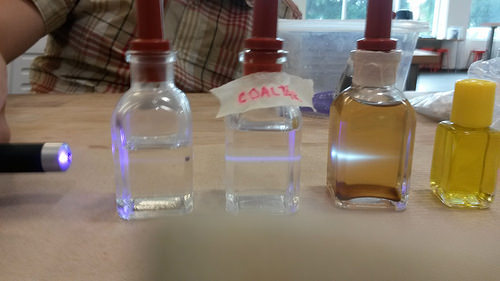
Team Orca resurrected --Gulf Monitoring Consortium test for BP tar
Draft
Reflections on the Alpha Oil Testing Kit
[to be continued]
Team Orca has rolled over. Eustis, Henderson, Jen (adios), Kearney (out of pocket).
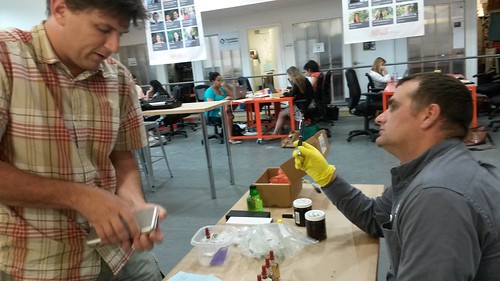
GMC has a need for field testing for oil.
1) is this Oil? the smell test is great, but the media wants visuals.
2) Is this BP's Oil? This will require some fingerprinting and spectralworkbench. This is a very tough question and the pros like Ed Overton at LSU, are having some trouble doing this as time passes. Can we make things work in field conditions?
[this is part one, non spectrometer results, appropriate for field]
[link older notes here, with the Orca tag]
http://publiclab.org/notes/eustatic/08-01-2013/making-grand-isle-coffee
http://publiclab.org/tag/orca
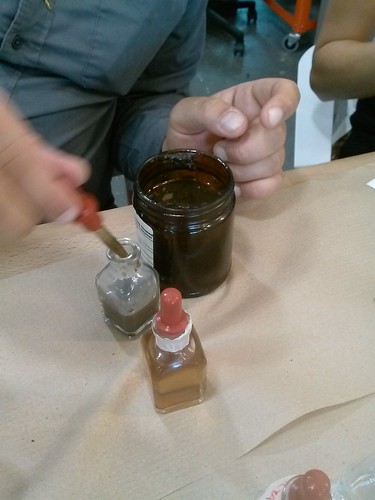
What was tested
<5mW vs <1000,W UV laser
--no difference to "eyeball" , both same freq
Control Mineral Oil and Coal Dust in Mineral Oil
So here we show the mineral oil, mineral oil with coal dust (shows the laser with minimal fluoresce) and Grand Isle Coffee 100x (laser stopped before olive oil)
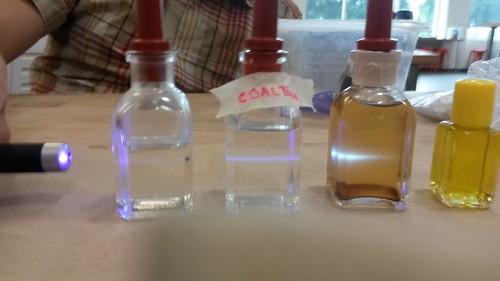
Olive Oil

Brake Fluid
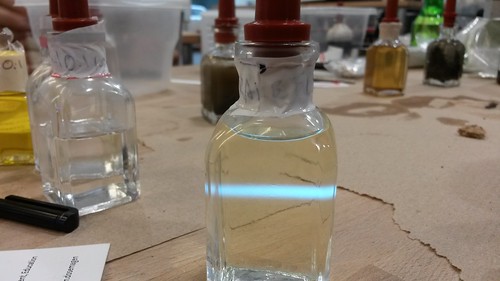
BP tar ball 100x, Grand Isle, 2013 (grand isle coffee) in mineral oil
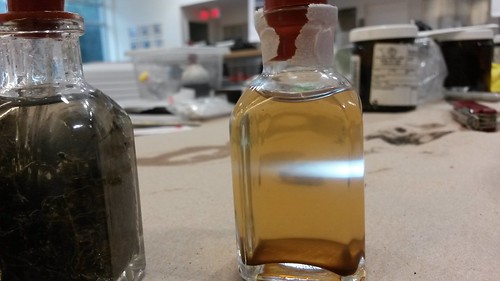
West Bay, TX after the Kirby Y spill
tbd
Bay Batiste water (no mineral oil except at top of vial)
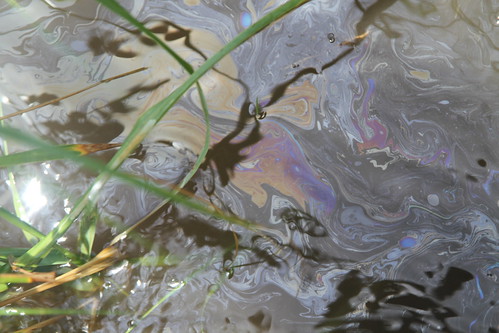
purple shows color of laser
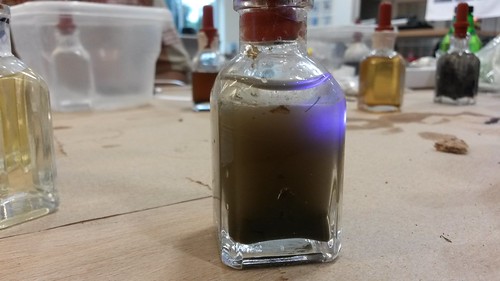
Bay Batiste Soil
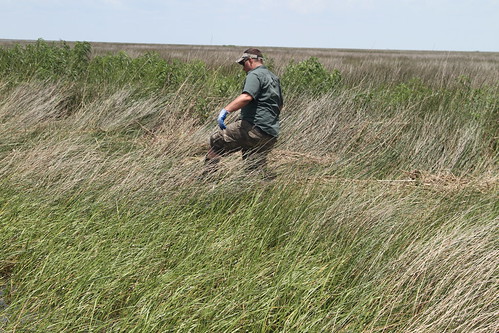
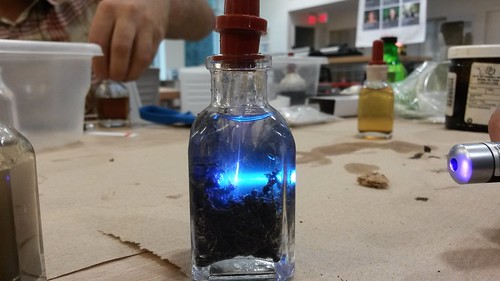
[When, where, what]
Now we know that unknown oil isn't veggie oil, and is more likely crude. but BP crude? Corexit?
Things that went well
like the rubber pipetters
mineral oil container less spilly and gross than commerical mineral oil ("top best" or some such)
nice small cuvettes for samples, but we defaulted to 30ml Barnes droppers for cuvettes
Challenges encountered
need oily proof labels, like painters tape, avery labels would not stick.
tyvek tape sticks!
Suggestions to improve the tool
misc
field photos https://www.flickr.com/photos/healthygulf/sets/72157644830850030
lab photos https://www.flickr.com/photos/eustatic/14506149522/
main image much larger https://farm6.staticflickr.com/5233/14324445688_189d7e59a6_h.jpg
Follow related tags:
gulf-coast spectrometer oil-spill oil

[GMC] [reference] on the need to monitor for Persistant Dispersant chemicals
Industry and US Government may be wrong on dispersant Corexit
"During the 2010 Deepwater Horizon (DWH) oil spill 1.84 M gallons of chemical dispersant were applied to oil released in the sub-surface and to oil slicks at the surface. We used liquid chromatography with tandem mass spectrometry (LC/MS/MS) to quantify the anionic surfactant DOSS (dioctyl sodium sulfosuccinate) in samples collected from environments known to contain oil persisting from the DWH oil spill. DOSS was found to persist in variable quantities in deep-sea coral communities (6-9000 ng/g) 6 months after the spill, and on Gulf of Mexico beaches (1-260 ng/g) 26-45 months after the spill. These results indicate that the applied dispersant, which was thought to undergo rapid degradation in the water column, remains associated with oil in the environment and can persist for ~4 years."
Long-Term Persistence of Dispersants following the Deepwater Horizon Oil Spill
http://pubs.acs.org/doi/abs/10.1021/ez500168r
Long-Term Persistence of Dispersants following the Deepwater Horizon Oil Spill
Helen K. White *†, Shelby L. Lyons †, Sarah J. Harrison †, David M. Findley †, Yina Liu ‡, and Elizabeth B. Kujawinski ‡ † Department of Chemistry, Haverford College, 370 Lancaster Avenue, Haverford, Pennsylvania 19041, United States ‡ Department of Marine Chemistry and Geochemistry, Woods Hole Oceanographic Institution, Woods Hole, Massachusetts 02543, United States Environ. Sci. Technol. Lett., Article ASAP DOI: 10.1021/ez500168r Publication Date (Web): June 23, 2014 Copyright © 2014 American Chemical Society
Questions and next steps
Can we develop a screening method with the alpha kit and a bunch of tar balls?
Why I'm interested
This issue should be elevated. Dispersant use should be regulated more scientifically, but to push EPA to do that will take citizens monitoring for themselves. Federal judges have not ruled in citizens' favor to push EPA to study dispersants.
Follow related tags:
gulf-coast spectrometer oil-spill fluorescence

Question: any low light settings for web cam used in desktop spectrometry kit?
I wanted to measure fluophore response to excitation with the supplied laser diode pen. The fluophore is disolved at an uknown concentration in destilled water and has optimum excitation with green light and responds also quite well with blue light. Fluorescence is orange/red and easily visible with the naked eye as well defined orange beam traversing the liquid. However due to the low light emission it is not picked up by the spectrometer. Possibly due to alignment problems with the slit of the spectrometer entrance. What diffuse light source could be suggested within the blue/green range to excite the fluophore and how to better the sensitivity of the web cam?
Background story
detection of fluorescent aptamer sensors in the field ("point of care") using inexpensive consumer goods technology like smart phones and public labs open software. Thanks Henry
Hi Jeffrey thanks for the response and apologies for my late reply.. I use as a fluorophor Atto 595 of unknown concentration but possibly in the range of 100 - 10 nmol/l. At the time it was used as an optical/fluorescence standard against td-tomato expressed in the cells of a genetically engineereda fluorescent biosensor. My measuring set up is the spectrometer in the card box orientated either with parallel or perpendicular orientation of the collimator slit towards the laser beam. Pics of my set up.
the green fluorescence in the left bottle is from Uranium glass splinters
The laser beam shows orange fluorescence to the naked eye transversing the liquid but the camera seems to pick up mostly the green from the laser reflected. The last pic is with blue excitation from the blue laser pen supplied with the kit. Henry
two more pics demonstrating that there is orange/red fluorescence from the fluorphore:
the last one taken with a red photographic filter in front of the lens (HOYA R=4/O-58). It totally blocks the geen laser light used for excitation
Follow related tags:
spectrometer uv laser fluorescence

Oil Fluorescence Testing station from a spectrometer box
Download the cut pattern as a pdf: cutpattern.pdf
What I want to do
modify the standard desktop spectrometer box to hold the laser, spectrometer, and sample bottle in the same repeatable locations. These are the components of our alpha version sampling kit, for sale here.
My attempt and results
I cutup three boxes, and then made this pattern download a PDF
Questions and next steps
make a print-ready PDF & vector file with measurements
Follow related tags:
spectrometer oil-testing-kit

Food grade oil samples
What I want to do
Prepare simple, food grade oil samples to use to explore oil spectral analysis. These will be used in Sunday's "spec-tacular" workshop in Brooklyn.
My attempt and results
I used three sterile, flat-sided, glass bottles and poured one kind of oil in each: olive oil, soybean oil, sesame oil.
Questions and next steps
The sesame oil is toasted, wondering how that might affect its spectrum.
Why I'm interested
This is a non-toxic way to begin exploring the spectral analysis of oils. Also i foresee that a shared methodology could develop between the identification of oil as an environmental contaminant and the detention of fraudulent oils sold for human consumption (more of an issue internationally than in the US).
Follow related tags:
new-york-city spectrometer oil spectroscopy















